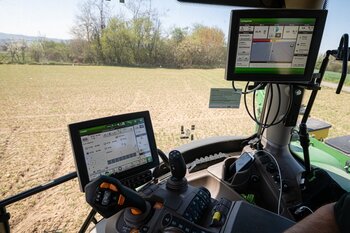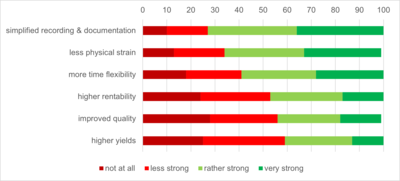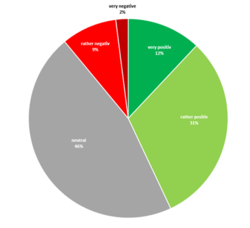Uptake & usage of Smart Farming in small-scaled agriculture

Uptake & usage of Smart Farming in small-scaled agriculture
Attitudes, motivation and investment intentions
 When talking about Precision Farming (PF) technologies, promised advantages by AgTech industries, media and advisors are about achieving more yield in plant and animal production as well as saving farm supplies which can also be described as “producing more with less”. At the same time there is a large number of farms across the EU which success is not mainly based on efficiency in primary production but in a valuable market position, receiving public-sector subsidies for environmental measures (e.g., those out of CAP) and diversification of goods and services.
When talking about Precision Farming (PF) technologies, promised advantages by AgTech industries, media and advisors are about achieving more yield in plant and animal production as well as saving farm supplies which can also be described as “producing more with less”. At the same time there is a large number of farms across the EU which success is not mainly based on efficiency in primary production but in a valuable market position, receiving public-sector subsidies for environmental measures (e.g., those out of CAP) and diversification of goods and services.
So how to convince these sorts of farms to get familiar with digital farming since there is no doubt that smart usage of new technologies leads to (upon other things) more environmental and animal-friendly ways of production? Therefore Austrian “Federal Institute of Rural Education and Training” recently launched a study based on more than 1.000 farmer interviews dealing with attitudes, motivation and investment intentions towards increasing digitization in agriculture.
© Ing. Gerald Pfabigan
Positive but also pragmatic
When asked about their general opinion about the growing importance of automatized machinery and digital tools nearly 90% of respondents indicated a neutral or rather positive attitude, while only 11% showed to be sceptical or even negative towards digital farming. Summed up this can be described by the following farmers quote “As long I benefit more of these technologies than I have to pay for them I will be open for it.” How can this be better described than “a quite pragmatic-positive approach”.
“How is your opinion towards automatization and digitization in agriculture?”
Farm management higher than production
Looking at the usage of concrete digital technologies, we see that there are mainly three groups of modern AgTech: farm management, plant production and livestock farming. It is no surprise that small scale farms show a high affection to the first group including Farm-Management-Information-Software (FMIS), pest risk alert services or messenger tools for communicating with colleagues. Users benefit from that no matter how many acres they manage neither there is no scaling up effects – unlike common precision farming equipment in arable farming where economical reasonability occur on a certain level of production quantity.
Interestingly, precision livestock farming (PLF) shows a higher adaption than PF in plant production, but this can likely be explained by the fact that usage of PLF has been proved for ~20 years (e.g., automatic milking systems). Farmers already have an experience that leads to trust in functionality even high investment intensity is usually linked to these technologies.
Reducing time exposure and labour
A further interesting point is the motivation aspect: When asked why to use or intend to use digital technologies farmers don’t argue with higher yields or performance but rather with easier environmental recording, less physical strain and increased time flexibility and leisure time. This can be explained by two reasons: First, in regions with small farms, there’s often a quite high number of those are led by part-time farmers. An additional job outside the farm leads usually to high pressure in terms of time availability.

“Why use digital technologies at your farm?”
On the other side, farmers have been asked about barriers towards digital farming. Very quickly, these can be described mainly by economic factors like doubtful cost-benefit considerations, initial investments as well as running costs. For experts working in extension services like advisory, it may be interesting that missing further education training is not indicated as a real obstacle. This may be evidence of well-working Agricultural Knowledge and Innovation System (AKIS) in Austria.
Serious interest on farm-side
The survey closed with several questions towards demanded education and advisory offers on the farm side. Again, we can draw out two main interesting results: First, a high share is open for visiting further training (68%) or even individual advisory (59%) dealing with digital technologies in their specific agricultural branches. Second, if there are asked for more detailed topics, they are interested in most answers containing common and very general agricultural challenges like “animal health”, “plant production” or “feeding”. These replies can be interpreted as a generally high interest in farming technologies, while many farmers seem to be not that far to articulate specific challenges or “next steps” for their individual farm.
What conclusions can be drawn?
There hardly seems to be a more prominent topic than a digital transition in today’s European agricultural debate. On a second look, the level of adaption of PF technologies seems to differentiate strongly between farming branches, farm sizes and therefore regions. Understanding this fact is crucial especially for member states that aim to take advantage of digital technologies but show a small-scaled farm structure. Concluding out of this recent Austrian study following principles should be recognized to obtain a fruitful digital transition in agriculture:
- • Follow low-cost and easily accessible digital tools in farm management with at least the same priority as large precision farming machinery! Try to realize some “quick wins”!
- • Farmers aim to be successful in farming rather than in digitization – the usage of digital technologies is no end in itself but has to be linked with an agronomic target.
- • Don’t overestimate scaling up effects – in particular, part-time farmers appreciate additional time savings even more than 1 of 2% of more yield.
- • Farmers can commonly be described as interested in technologies but also as critical consumers: If machinery or another digital tool don’t lead to a valuable and measurable benefit that is higher than its engaged costs application will not be regarded as useful.
- • Nevertheless, digital farming technologies will go on with their triumphant advance since year-by-year average European farms are getting larger and more professional and since there’s a societal pressure to become more efficient with farm input. That’s also reflected by a high share of farmers in the interview study stated likely to invest in PF technologies within the next 5 years.
 Martin Hirt, Expert on digital agriculture, Dept. Agricultural and Regional Policy, Knowledge Transfer & Innovation, Austrian Chamber of Agriculture, SmartAgriHubs Regional Cluster Central Europe
Martin Hirt, Expert on digital agriculture, Dept. Agricultural and Regional Policy, Knowledge Transfer & Innovation, Austrian Chamber of Agriculture, SmartAgriHubs Regional Cluster Central Europe

